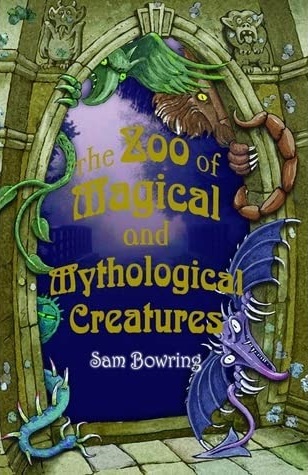Title of the work
Country of the First Edition
Country/countries of popularity
Original Language
First Edition Date
First Edition Details
Sam Bowring, The Zoo of Magical and Mythological Creatures. Sydney: Pan Macmillan, 2009, 186 pp.
ISBN
Genre
Fantasy fiction
Fiction
Mythological fiction
Novels
Target Audience
Children (Suggested reading level age 9–11)
Cover

Courtesy of the Author.
Author of the Entry:
Miriam Riverlea, University of New England, mriverlea@gmail.com
Peer-reviewer of the Entry:
Elizabeth Hale, University of New England, ehale@une.edu.au
Daniel A. Nkemleke, University of Yaoundé 1, nkemlekedan@yahoo.com

Courtesy of the Author.
Sam Bowring
, b. 1980
(Author)
Sam Bowring lives in Sydney, Australia. He has published a number of fantasy novels as well as two picture books, The Little Bad Wolf (2016) and Sam the Cat (2012). He also writes for television, and has been performing as a stand-up comedian since the age of sixteen. He is also the creator of Bedlam, a card game featuring a myriad of irreverent cultural references and the graphic art of Mike Foxall. In 2010, The Zoo of Magical and Mythological Creatures was recognised as a Children’s Book Council of Australia Notable Book.
Source:
Official website (accessed: July 4, 2018).
Bio prepared by Miriam Riverlea, University of New England, mriverlea@gmail.com
Summary
Twelve-year-old Zackary is the youngest prince in the royal family of Zedge. His parents dote on him, but they are also exasperated – every tutor in the kingdom has declared him unteachable. After failing his training as a knight, Zackary is sent to assist Barnabus, the chaotic Royal Accountant, who files palace documents in his fireplace. When Barnabus sends Zackary on an errand to the nearby Zoo of Magical and Mythological Creatures, he discovers the allure of a place his parents have always forbidden him to visit. Established by Zackary’s grandfather King Ezra, the Zoo is full of exotic and legendary creatures, including a flock of Stymphalian Birds, Unicorns and Manticores, and a ten-headed Hydra.
Marlowe, the Zoo’s Director, assumes Zackary has come to apply for a job, and without reflecting much on the consequences, he accepts the position of Sorcerer’s Assistant. He conceals his royal identity from Marlowe and his daughter Acacia, who has just been promoted to be the new Sorcerer. Though initially unimpressed by Zackary, Acacia grows to appreciate his support and the two become friends. Powerful magic is needed to keep the creatures from escaping their enclosures. The manticores are tempered with sleeping potions to keep them docile. The Mermaids, who have the allure and the menace of the Sirens, must be carefully monitored to ensure their tank remains secure and that male visitors do not fall under their spell. Other creatures require a different sort of management. The Squonks are small trolls with baggy skin, terrible warts, and low self esteem. Knowing themselves to be the ugliest creatures in the world, they cry constantly, to the point that their tears are depleted of their salt content. Acacia and Zackary must prevent the Squonks from dissolving in a puddle of their own tears.
Then the monster hunter Carson arrives from the Orkney Isles with the Zoo’s newest exhibit, the Nuckelavee, a terrifying hybrid of horse and man with a single eye and no skin covering its muscular flesh. Zackary becomes involved in the challenge of finding a way to safely house this creature, and discovers the answer in his Grandfather’s old diaries. The Nuck is unable to cross any body of fresh water, and the weeping Squonks are enlisted as its ideal guardians.
When the royal family visits the Zoo to view the new exhibit, they are shocked to find Zackary working there. His parents give him an embarrassing public dressing down, but Zackary feels most terrible for deceiving Acacia. Back in the castle, Zackary uses his grandfather’s diaries to persuade his parents to permit him to continue working in the zoo with Acacia.
Analysis
The Zoo of Magical and Mythological Creatures is a work of fantasy that references a wide range of mythological and folkloric material. Descriptions of the signage on the zoo enclosures provides an opportunity to allude to stories about the creatures in the zoo, from the Ancient Greek Hydra to the fictitious Fur-Bearing Trout of North America.
The text draws upon an extensive range of mythological traditions. The Zoo is a site in which creatures from Greek, Indian, North American, and Scottish mythology, among other traditions, cohabit. The way in which the Orcadian Nuckelavee is guarded by the Squonks from North America embodies Bowring’s blending of cross-cultural elements.
When the Stymphalian Birds escape from their enclosure, Zackary relies on knowledge of the way in which Heracles combated the creatures with brass clappers to recapture them (p. 112). This depiction of a character re-enacting the details of a myth features in a significant number of retellings, including Francesca Simon’s Helping Hercules (1999).
Though a lighthearted text, the work also touches on more serious issues. Readers are invited to reflect on the ethics of keeping creatures in captivity. And through the depiction of Acacia and the female monster hunter Carson, the work promotes a feminist ethos. When the pair are introduced, Carson remarks that it is "[g]ood to see strong young women in the workplace" (p. 132).
Further Reading
Hale, Elizabeth, “Friday essay: Feminist Medusas and outback Minotaurs – why myth is big in children’s books”, in The Conversation, June 3, 2016, available at theconversation.com (accessed: August 2, 2018).


